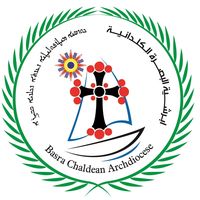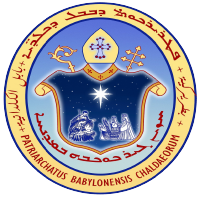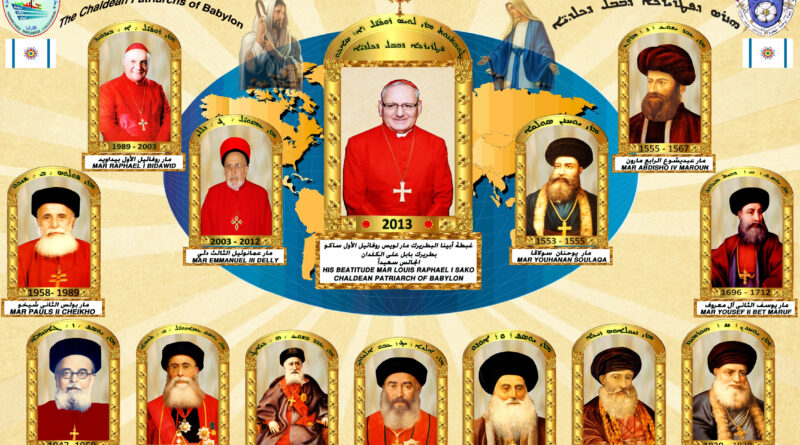Traditions of the Chaldean Catholic Church
by Dr Joseph Seferta
Birmingham/UK
Part II
Monks, Nuns and Missionaries:
Monasticism has existed in the Chaldean Church since Sassanid times, in spite of continuous waves of persecution. Records indicate that, back in the 4th century, there were “Sons and Daughters of the Covenant” whose lives were characterised by prayer, fasting, chastity and constant work and study. Monks and nuns lived separately and their way of life absorbed influences from Egypt and Byzantium. Records give the names of old monasteries as well as the names of famous monks, two of whom (Ahai and Yabalaha I) became patriarchs. Monks pursued theological and scholarly studies at various academic centres, especially Edessa and Nisibis in Northern Mesopotamia. While most lived in monastic communities, some preferred to live as hermits, and others spent their days as itinerant preachers.
The most famous monastic founder in Chaldean history is Rabban Hormiz in the 7th century, who was based in Alqosh, north of Mosul. Monastic life was thriving during the Abbasid times when countless precious manuscripts were produced. But, during the Mongol and Ottoman periods, we find that convents were fast disappearing for lack of security and fear of kidnapping and rape. Today, hundreds of monasteries lie in ruins, and only a handful are functioning as centres of pilgrimage, retreat and social gathering. The monks are always happy to offer their traditional hospitality.
A much-needed reform of monasteries took place in the 19th century, when Abbot Gabriel Danbo (who belonged to the Order of Rabban Hormiz and was trained by the Maronite monks of St. Anthony in Lebanon) rose to the challenge. He was so successful that, in addition to Rabban Hormiz Monastery, Our Lady’s Monastery (Der al-Sayyida) also had to be built in 1855 to accommodate all the new monks. In the second half of the 20th century, however, monasteries suffered severe destruction due to wars between the Iraqi governments and the Kurds. Hence, most monks moved down to Baghdad where they founded St. Anthony’s Monastery. The major seminary (established by the Dominicans in Mosul) was also transferred to Baghdad by Patriarch Cheikho.
The recruiting of nuns, at both local and national levels, as well as building convents, resumed in 1911. Chaldean nuns today belong to two orders: The Nuns of the Sacred Heart and The Nuns of the Immaculate Conception. Monasteries and convents have also been built in other countries where Chaldeans live, such as Lebanon, Jordan, France, Australia and the United States. There are also Chaldean monks and nuns who belong to Western missionary orders, such as the Carmelites, Dominicans, Franciscans, Redemptorists, Jesuits and the Little Sisters of Jesus.
European Catholic missionaries began arriving in Iraq in increasing numbers in the 17th century. The Capuchins were followed by the Carmelites who founded the first Catholic primary school (St. Joseph’s) in Baghdad in 1721. In the 19th century, the Dominicans opened several primary schools in Mosul and the surrounding villages, as well as the major seminary, which produced some 200 priests (Chaldean as well as Syrian), many of whom later became bishops and even patriarchs. French Dominican sisters also founded schools both in Mosul and Baghdad, as well as the famous St. Raphael’s Hospital in the capital. The French were eventually replaced by Iraqi sisters. The 20th century also witnessed the church of Iraq being supported by the services of Belgian Redemptorists, American Jesuits and Mother Teresa’s Sisters of Charity.
Part III
Art, Literature and Education:
Chaldean art began at a very early stage, mainly by developing various forms of the cross and paintings relating to Jesus and the Gospel stories. The arts remained simple, however, and never approximated the sophistication of the Byzantine icons or the Roman statues. But the Babylonian style of architecture is well known, and many surviving churches retain impressive decorations and ornaments. Another form of art that has survived is calligraphy, both in Syriac and Arabic, as well as the art of designing manuscripts. In recent times, scores of Chaldean artists, both in East and West, have participated in exhibitions, with some winning awards.
Like other villages around the world, Chaldean villages in Northern Iraq celebrate their festivals with singing, dancing and colourful costumes. Particular fervour is displayed on the feast of the village patron saint (shiri), during which people visit their local monastery as well. The religious is mixed with the secular, and the famed Iraqi hospitality is displayed particularly in the abundance of the food.
The Chaldean liturgical chant is still distinctive and melodious, and much of the wording is attributed to St. Ephrem who was a remarkable poet and composer. Developed by Mar Isho-Yab III, it was further refined in schools and monasteries in subsequent centuries. In the 19th century, it was also enhanced by the Dominicans with their modern musical instruments and technology. It was the Dominicans who introduced the first printing press in Mosul in 1859, which helped revive the arts, literature and education, for both Christians and non-Christians. They also launched the first model school in Ottoman times and the first theatrical plays in the 1880s. Thanks to that tradition, there has been an explosion of talent by Chaldeans in the fields of drama and the theatre, over the past few decades, particularly in the United States.
With regard to literature, Chaldeans can boast of a long history of distinguished thinkers and writers in numerous fields. Under Persian rule, Mar Shimun Bar Sabba’i left behind numerous letters, prayers and hymns, though, unfortunately, very few are now extant. Much more though has survived of the writings of St. Ephrem, who was labelled by St. John Chrysostom “the harp of the Holy Spirit”. This greatest of Syriac saints is on a par with other notable saints of the East, such as Basil, Athanasius and Gregory of Nyssa. Ephrem wrote in Syriac about Scripture, theology, monastic spirituality and the liturgy, but he is most famous for producing excellent hymns and poems that are still used by all Syriac-speaking churches.
Another distinguished Chaldean saint and scholar is Mar Narsai (d. 501). Like Ephrem, he too was a monk and, after teaching and writing for many years at the School of Nisibis, he helped establish the School of Edessa. Following the teachings of Nestorius and Theodore of Mopsuestia, and refuting Monophysitism, he produced works on theology, biblical exegesis, the liturgy and ethics. His prayers and hymns are still used by Chaldeans and Assyrians alike.
Under the Abbasid dynasty, three outstanding scholars come to mind: Patriarch Timothy I, Hunain ibn Ishaq and Gregorios Ibn al-Ibri. The last is better known in the West as Bar Hebraeus (d. 1286) and is often likened to Albert the Great and Thomas Aquinas. He was both a philosopher and a bishop of the Syrian Orthodox Church, whose writings covered a wide range of subjects, both religious and secular. He wrote both in Arabic and Syriac. Other respectable thinkers and writers appeared in subsequent centuries, but we cannot list them all.
When Iraq gained its independence in 1932, Christians played a very prominent role in the foundation of the new country. The chaldean patriarch was ex officio a member of the senate during the monarchy, while other notable Christians joined the House of Representatives, with many Chaldeans and other Christians (as well as some Jews) becoming leaders in such fields as law, science, archaeology, journalism, hotel management and Arabic language and literature. They all served their country faithfully, even in the face of popular prejudice and discrimination. The first Iraqi nurses were trained by the Dominican Sisters of the Presentation, who also ran schools.
In 1932, and following an appeal by the Chaldean Patriarch Yusuf Emmanuel II, American Jesuits of the New England Province founded Baghdad College, a secondary school for boys that was open to Christians and non-Christians alike, and proved to be consistently the top school in the country. They also founded a very promising university called Al-Hikma (named after the famous Abbasid institute Beit al-Hikma or “House of Wisdom”). Sadly, however, due to the strong anti-American sentiments within the Ba’th regime, both institutions were taken over by the government in the late 1960s, and all the American Jesuits were subsequently and rudely expelled.
With all Christian institutions being nationalised, the church in Iraq had to adjust itself to the new situation by organising a system of religious education courses within the parishes. Patriarch Bidawid founded Babylon College both as a major seminary and theological institute, open to clerics and lay people alike from all Christian denominations. It was a brave ecumenical venture that numbered at one time around 100 students, half of whom being Chaldeans. The Chaldean Church also ran various spiritual, cultural, social and charitable societies, in addition to a printing press, a radio station and a number of websites, including a patriarchal one. A variety of publications was produced, the most popular being Najm al-Mashriq (Star of the East) and Bein al-Nahrain (Mesopotamia). This is not counting other publications, organisations and numerous activities taking place by the Chaldeans outside Iraq.



